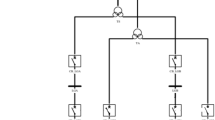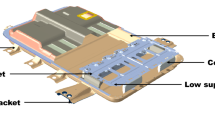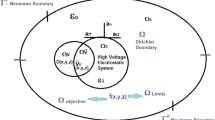Abstract
Reliability assessment is the key to the reliability design of a complex system. This paper takes the lithium battery pole slice separators (LBPSS) as the research object and selects the superposition Weibull model as the initial model. Based on the graphic method, a pivot quantity is introduced to estimate the range of scale parameters. A genetic algorithm is used to optimize parameters in a given parameter interval. Compared with other models and techniques, using the superposition Weibull model, pivot quantity, and graphic method to evaluate the reliability of LBPSS is more reasonable, provides a reference for improving the reliability and maintainability of LBPSS, and lays a theoretical foundation for analyzing the failure mode and failure mechanism of a complex system.
Similar content being viewed by others
Abbreviations
- LBPSS :
-
Lithium battery pole slice separators
- MTBF :
-
Mean time between failure
- S-LLP :
-
Superposed log-linear process
- WPP :
-
Weibull plotting paper
References
S. Shuguang, Z. Wenjie and Z. Meng, Fault analysis of CNC equipment based on DEMATEL/ISM/ANP, Journal of Mechanical Science and Technology, 34(8) (2020) 3181–3188.
P. R. Bhimgonda, B. S. Kothavale and W. L. Yadu, Selection of time-to-failure model for computerized numerical control turning center based on the assessment of trends in maintenance data, Proceedings of the Institution of Mechanical Engineers, Part O: Journal of Risk and Reliability, 233(2) (2019) 105–117.
Z. Wang and J. Yang, Reliability assessment of numerical control machine tools using weibull mixture models, Advanced Materials Research, 1100 (2011) 161–165.
Y. He, A. Kusiak and T. Ouyang, Data-driven modeling of truck engine exhaust valve failures, A Case Study, 31(6) (2017) 2747–2757.
Z. Yuan, S. Fu and D. Wang, Reliability evaluation of aeroengine based on Weibull mixed distribution, Aeronautical Computing Technology, 45(5) (2015) 65–67.
O. S. Ewemooje and T. A. Ewemoje, Efficiency of modified mixed gamma distribution in estimating annual maximum and minimum flows at moniya gauging station, nigeria, Asian Journal of Water, Environment and Pollution, 16(3) (2019) 99–107.
Y. Guo, Y. Sun and L. Li, Reliability assessment for multisource data of mechanical parts of civil aircraft based on the model, Journal of Mechanical Science and Technology, 33(7) (2019) 3205–3211.
Y. Li, G. Wang and M. Li, Application of CT images in the diagnosis of lung cancer based on finite mixed model, Saudi Journal of Biological Sciences, 27 (2020) 1073–1079.
R. Ghavijorbozeh and A. Z. Hamadani, Application of the mixed weibull distribution in machine reliability analysis for a cell formation problem, International Journal of Quality and Reliability Management, 34(1) (2017) 128–142.
P. Hao, Y. Wang and B. C. Liu, A novel non-probabilistic reliability-based design optimization algorithm using enhanced chaos control method, Computer Methods in Applied Mechanics and Engineering, 318 (2017) 572–593.
M. Mahmud, S. Abdullah and S. S. K. Singh, Distribution characterisation of coil spring strain histories using mixed weibull analysis, International Journal of Engineering and Technology, 7(3.17) (2018) 110–117.
Z. Yuan, J. Deng and D. Wang, Reliability estimation of aero-engine based on mixed Weibull distribution model, IOP Conference Series: Earth and Environmental Science, 113 (012073) (2018).
M. M. Hasan, B. F. W. Croke and S. Liu, Using mixed probability distribution functions for modelling non-zero sub-daily rainfall in Australia, Geosciences, 10(2) (2020) 43.
D. B. Kececioglu and W. Wang, Parameter estimation for mixed-Weibull distribution, Annual Reliability and Maintainability Symposium, IEEE (1998) 247–252.
P. K. Chaurasiya, S. Ahmed and V. Warudkar, Study of different parameters estimation methods of Weibull distribution to determine wind power density using ground based doppler SODAR instrument, Alexandria Engineering Journal, 57 (2018) 2299–2311.
Z. Lu, L. Dong and J. Zhou, Nonlinear least squares estimation for parameters of mixed weibull distributions by using particle swarm optimization, IEEE Access 2019, 7 (2019) 60545–60554.
J. K. Freels, D. A. Timme and J. J. Pignatiello, Maximum likelihood estimation for the poly-Weibull distribution, Quality Engineering (2019) 1–8.
M. Nagode and M. Fajdiga, An improved algorithm for parameter estimation suitable for mixed Weibull distributions, International Journal of Fatigue, 22(1) (2000) 75–80.
L. Ren, Z. Rui and J. Liu, Whole lifecycle reliability assessment of multiple NC machine tools with minimal repair, Journal of Shanghai Jiaotong University, 49(1) (2015) 19–23.
X. Zhai, J. Wang and J. Chen, Parameter estimation method of mixture distribution for construction machinery, Mathematical Problems in Engineering, 2018 (2018) 1–9.
K. Chi, J. Kang and K. Wu, Bayesian parameter estimation of weibull mixtures using cuckoo search, 2016 International Conference on Intelligent Networking and Collaborative Systems (INCoS), IEEE (2016).
P. Hao, Y. Wang and R. Ma, A new reliability-based design optimization framework using isogeometric analysis, Computer Methods in Applied Mechanics and Engineering, 345 (2019) 476–501.
L. I. Li, X. Wei and Z. Yi-Jie, Mixed Weibull distribution model of transmission line fault based on fuzzy genetic algorithm, Journal of Electric Power Science and Technology (2018) 60–66.
Y. Lin, C. Lin and X. Qiu, Fuzzy comprehensive evaluation method of masonry structure safety based on grey clustering theory, Mathematical Problems in Engineering (2018) 1–15.
W. L. Hung, Y. C. Chang and S. C. Chuang, Fuzzy classification maximum likelihood algorithms for mixed-Weibull distributions, Soft Computing, 12(10) (2008) 1013–1018.
H. Zhang and Z. Li, Anomaly detection approach for urban sensing based on credibility and time-series analysis optimization model, IEEE Access, 7 (2019) 49102–49110.
J. Martin and C. Elster, Inspecting adversarial examples using the Fisher information, Neurocomputing, 382 (2020) 80–86.
J. Guo, Z. Li and T. Keyser, A Bayesian approach for integrating multilevel priors and data for aerospace system reliability assessment, Chinese Journal of Aeronautics, 31(1) (2018) 41–53.
P. Yang, H. Li and S. Hou, Log likelihood ratio-based relaying for distributed turbo codes, Journal of Beijing Institute of Technology, 27(2) (2018) 176–181.
R. Jiang, Characteristics, Parameter Estimation and Application of Weibull Model Family, Science Press, Beijing, China (1998).
S. Mao, Y. Cheng and X. Pu, Probability Theory and Mathematical Statistics, Higher Education Press, Beijing, China (2004).
Acknowledgments
This work was supported by the Ministry of Industry and Information Technology Smart Manufacturing New Model Project (Research on Key Technologies of Liquid Supply System), China. The authors are grateful to the referees for their constructive comments and suggestions, which have improved the manuscript.
Author information
Authors and Affiliations
Corresponding author
Additional information
Recommended by Editor Chongdu Cho
Dongwei Gu is a Teacher at the School of Mechatronic Engineering of Changchun University of Technology, Changchun, China. He received his Ph.D. in Mechanical Engineering from Jilin University of China. His research interests include reliability modeling and preventive maintenance. He has published over 20 academic articles. Dr. Gu is a member of the Chinese Mechanical Engineering Society.
Jinhan Gao was born in Changchun City, Jilin Province, China, on October 9, 1995. She graduated with a Bachelor’s degree in Engineering from the Mechanical Engineering of School of Humanities and Information, Changchun University of Technology, Changchun City, Jilin Province, China in 2018. She majored in Mechanical Engineering at the Graduate School of Mechanical Engineering of Changchun University of Technology. Her research direction is reliability. She won the third class scholarship in school. When she was in university, she had some knowledge of reliability, but now she is more interested in reliability.
Yuhong Zhong was born on April 8, 1997 in Jiaxing, Zhejiang. She received an engineering degree, majoring in Reliability Engineering, from the Changchun University of Technology in 2019 and is working toward a B.S. degree at the Changchun University of Technology, Changchun, Jilin Province. She won two national inspirational scholarships at the School of Humanities and Information of the Changchun University of Technology. She is currently a student. Her current research interest is the analysis of importance.
Zhen Xu was born in Zibo City, Shandong Province, China on December 15, 1995. He graduated from Shandong Linyi University in 2017, majoring in Mechatronics with a University degree. He graduated from Shandong Zaozhuang University in 2019 with a Bachelor’s degree in Mechanical Design, Manufacturing, and Automation. He won a scholarship at Linyi University. He is currently studying for a Master’s degree at Changchun University of Technology. His research interests include reliability prediction and maintenance.
Rights and permissions
About this article
Cite this article
Gu, D., Gao, J., Zhong, Y. et al. Scale parameter assessment based on pivot quantity for reliability analysis of a complex system. J Mech Sci Technol 35, 1007–1015 (2021). https://doi.org/10.1007/s12206-021-0214-z
Received:
Revised:
Accepted:
Published:
Issue Date:
DOI: https://doi.org/10.1007/s12206-021-0214-z




